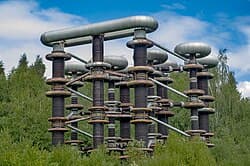Istra High Voltage Research Center Capable of Generating 150-Meter Artificial Lightning

Near Istra, Russia – The Istra High Voltage Research Center, a Soviet-era testing facility established in the 1970s by the Moscow Power Engineering Institute, stands as a monument to high-voltage scientific exploration. The facility gained notoriety for its massive electrical apparatus, including what is believed to be the world's largest Marx generator, alongside several immense Tesla coils. These components were designed to simulate natural phenomena, notably capable of producing artificial lightning discharges up to 150 meters in length.
Originally conceived for a dual purpose of military and scientific research, the center's primary function was to test the lightning insulation and electromagnetic radiation resistance of critical equipment, including military aircraft. Its impressive infrastructure includes a 3-megawatt transformer cascade, a 9-megawatt Pulsed Voltage Generator, and a 2.25-megawatt constant voltage unit. The scale of these installations allowed for groundbreaking research into high-voltage physics and its applications.
The facility is particularly recognized for its towering Tesla coils, some of which reportedly exceed 20 stories in height. As noted by a recent social media post, "The Istra High Voltage Research Center in Russia. A Soviet-operated testing facility built in the 1970s operated by the Moscow Power Engineering Institute. Having several huge Tesla coils on the facility grounds, some of which range over 20 stories in height!" This description highlights the sheer vertical scale of the experimental equipment.
Following the dissolution of the Soviet Union in 1991, the Istra High Voltage Research Center largely ceased its active operations, becoming mostly inactive due to underfunding. While its primary research activities have diminished, the site has occasionally been utilized for private sector testing, such as evaluating the lightning strike resistance of the Sukhoi Superjet 100 in 2011. The Marx generator, a key component, was last recorded in use in August 2014, underscoring the facility's current intermittent operational status.
Despite its current dormancy, the Istra center remains a significant site in the history of high-voltage engineering. Its unique and imposing structures continue to attract interest from photographers and enthusiasts, serving as a stark reminder of ambitious Soviet scientific endeavors. The high cost associated with powering its colossal generators means that full-scale operations are rare, preserving its status as a historical landmark of technological prowess.